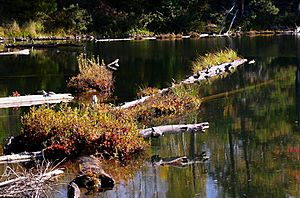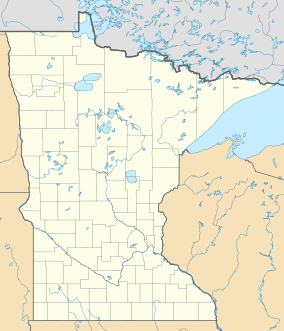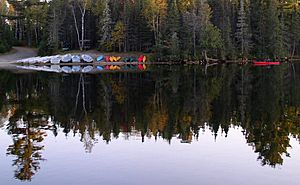Bear Head Lake State Park facts for kids
Quick facts for kids Bear Head Lake State Park |
|
|---|---|

Bear Head Lake from a trail in the campground
|
|
| Location | Saint Louis County, Minnesota, United States |
| Area | 4,373 acres (17.70 km2) |
| Elevation | 1,506 ft (459 m) |
| Established | 1961 |
| Governing body | Minnesota Department of Natural Resources |
Bear Head Lake State Park is a beautiful state park in Minnesota, United States. It's a great place to enjoy the outdoors in the Boundary Waters area. The park offers amazing views, much like the nearby Boundary Waters Canoe Area Wilderness. However, it's easier to get to, has modern facilities, and you can use motorboats.
Many visitors love to go boating, fishing, swimming, and hiking here. The park completely surrounds Bear Head Lake, which is about 670 acres (270 hectares) big. It also includes three other lakes where you can fish. Bear Head Lake State Park was created in 1961 in Saint Louis County, close to Ely, Minnesota. The park covers about 5,540 acres (2,240 hectares) of woodlands and lakes. It also shares a long border with Bear Island State Forest.
In September 2010, something amazing happened: Bear Head Lake State Park was voted "America's Favorite Park" in a huge online poll! This park wasn't even one of Minnesota's most famous. It won by a lot, getting 28% of over 5.7 million votes. Many people believe the win was thanks to online fans of a mother and cub black bear family. These bears were featured on a popular webcam, and their home included parts of the park.
Contents
Exploring Bear Head Lake State Park
Bear Head Lake State Park is located in Saint Louis County, about 19 miles (31 km) southwest of Ely. It's also 18 miles (29 km) east of Tower. You can find the park entrance on County Road 128. The land in the park goes from about 1,450 feet (440 m) to 1,590 feet (480 m) high. The Laurentian Divide also runs through the southern part of the park. This is a special line where water on one side flows to the Atlantic Ocean, and water on the other side flows to the Arctic Ocean!
The park completely surrounds Bear Head Lake and four smaller lakes. It also has parts of the shorelines of three other lakes. Bear Head Lake has 11.7 miles (18.8 km) of shoreline. It's about 12 feet (3.7 m) deep on average, and its deepest spot is 46 feet (14 m). The park also includes part of Eagles Nest Lake No. 3, which is about 966 acres (391 hectares). Other lakes like Blueberry Lake, Square Lake, Cub Lake, and Norberg Lake are also inside the park. Many other small ponds and wet areas are found throughout the park.
Bear Head Lake State Park is mostly surrounded by Bear Island State Forest. Parts of Superior National Forest are nearby, and the famous Boundary Waters Canoe Area Wilderness is about 20 miles (32 km) away.
Nature's Wonders
Park's Rocky Past
The land at Bear Head Lake State Park has rolling hills, steep areas, and rocky ridges. You can see bedrock (the solid rock under the soil) sticking out in many places. This bedrock is very old, formed about 2.7 billion years ago! Some of it is Granite, and other parts are from ancient underwater volcanoes.
Long ago, during the ice ages, huge glaciers moved across this area. They scraped the land down to the bedrock. When the last glaciers melted about 10,000 to 12,000 years ago, they left behind a thin layer of rocky soil. They also formed thick ridges of sand and rocks called moraines.
Plants and Trees

Most of Bear Head Lake State Park is covered in forests. The types of plants and trees you see depend on the soil and location. Over time, people have changed the forest quite a bit.
Long ago, the park was mostly covered with huge eastern white pine and red pine trees. You can still see some of these very old, tall pines in the picnic area today. However, a lot of logging happened around 1900. After that, wildfires changed the forest even more. Now, much of the park has a newer, or "secondary," forest.
In wet, peaty areas, you'll find different kinds of coniferous swamps. These include black spruce bogs, tamarack bogs, and white cedar swamps. These areas have special plants that like wet soil, like bog Labrador tea and leatherleaf.
The park also has different types of upland forests. Pine forests grow on flat areas and hillsides. They have a mix of red and white pines, along with other trees like balsam fir and paper birch. Other areas have aspen–birch forests, which are common after logging. These forests are full of trembling aspen and paper birch trees.
Amazing Animals
Bear Head Lake State Park is surrounded by quiet forestland. This means it's home to many different kinds of animals, more than you might see in parks closer to cities. You might even spot large mammals like moose, black bears, and timber wolves.
More often, you'll see white-tailed deer, red foxes, snowshoe hares, red squirrels, and eastern chipmunks. Other animals living here include beavers, river otters, and different kinds of small rodents.
The park is also a summer home for many birds. You can see classic Boundary Waters birds like the common loon (Minnesota's state bird!), bald eagles, ospreys, and common ravens. Other special birds include the red-breasted nuthatch and pine grosbeak.
Different parts of the forest attract different birds. For example, the aspen–birch forests are home to ovenbirds and red-eyed vireos. In the pine forests, you might find Blackburnian warblers and hermit thrushes. In winter, only a few tough birds stay, like black-capped chickadees and hairy woodpeckers.
You can also spot birds of prey like broad-winged hawks and American kestrels. Water birds like the great blue heron and common merganser are often seen near the lakes.
Park's History
From Logging to Park
Not much is known about the very early history of the Bear Head Lake area. Native American sites have been found outside the park, dating back thousands of years. In the late 1700s, European fur traders came to the region and traded with the local Native Americans. Later, a treaty in 1854 allowed more European-American settlers and industries to come to the area.
In 1885, someone even tried to open a gold mine in the northern part of what is now the park, but they didn't find any gold. Logging began around Bear Head Lake in 1895. A sawmill was built on the south shore in 1907, but it was taken apart in 1911. Old logging railroads used to serve the sawmill, and you can still see parts of these old railbeds in the park today. After the logging, the area was mostly quiet, with just a few private cabins by the lake.
How the Park Was Born
Bear Head Lake State Park was created quite easily because much of the land was already owned by the state. In 1959, two forestry officials were visiting the area and thought it would make a great state park. They shared their idea, and local people supported it. In 1961, a bill was passed by the Minnesota Legislature to create the park, and Governor Elmer L. Andersen signed it into law.
Most of the park's land was already public. The private owners of the remaining land were happy to sell it to the state. Work on the park started right away. The campground, picnic area, and roads were ready by October 1961. The park was officially dedicated on June 26, 1962. More land was added to the park in 1963 and in the early 2000s.
"America's Favorite Park" Win
In September 2010, Bear Head Lake State Park surprisingly won the first "America Is Your Park" online poll. This contest was sponsored by Coca-Cola and the National Park Foundation. People could vote as many times as they wanted for any U.S. park to win $100,000 and the title "America's Favorite Park." Bear Head Lake received over 1.6 million votes, beating Great Smoky Mountains National Park by more than half a million! This was amazing for a park that only had about 100,000 visitors a year.
The park's win was partly due to the online fans of Lily and Hope, a mother and cub black bear family. These bears were part of a popular webcam run by biologist Lynn Rogers from the North American Bear Center in Ely. Some of his research bears live in the park. Many of the bears' 200,000 Facebook and webcam fans helped spread the word about the contest. This online support had helped the Ely community win other grants and contests before.
The Minnesota Department of Natural Resources received a big check for $100,000. They announced that the money would be used to build a trail center at Bear Head Lake State Park. This new center will be a great place for visitors to gather all year round.
Fun Things to Do
Bear Head Lake State Park offers the beautiful North Woods scenery of the Boundary Waters, but with easy access and modern facilities. It's a great place to get a "first taste" of the wilderness. The park is especially known for its excellent fishing and canoeing.
You can launch boats at Bear Head Lake and Eagles Nest Lake No. 3. Bear Head Lake also has a sandy swimming beach, a canoe launch, and a fishing pier that's easy for everyone to use. Both of these large lakes have fish like northern pike, walleye, black basses, and black crappie. Smaller lakes like Norberg and Cub Lakes are stocked with brook trout.
If you want to stay overnight, the park has several options. The main campground has 73 sites, and 45 of them have electricity. There are also five cozy camper cabins. The campground has showers and flush toilets. You can also rent a guesthouse with a full kitchen that sleeps up to 10 people. For larger groups, there's a secluded group camp for up to 50 tent campers. If you like to backpack or boat, there are six backcountry campsites scattered around the park.
The park has about 17 miles (27 km) of trails. In winter, 9 miles (14 km) of these trails are groomed for cross-country skiing. The rest of the park is open for snowshoeing. The Taconite State Trail, which is 165 miles (266 km) long, also runs through the park. It has a 1-mile (1.6 km) spur that leads to the picnic area, perfect for snowmobiles.




